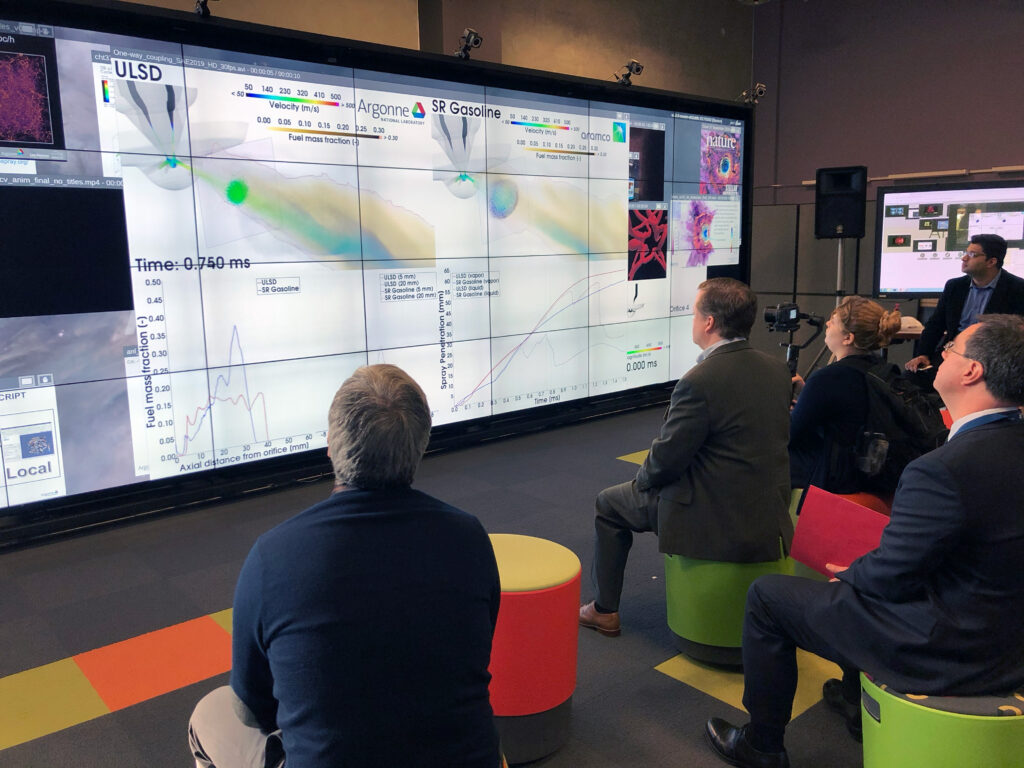
Author:
Elizabeth Favreau
Marketing Writing Team Lead
From the Argonne National Laboratory + Convergent Science Blog Series
The world is waiting for us to develop the tools needed to design new engine architectures, new concepts, with a finer control over the combustion process. If we can continue to make the progress we’ve achieved over the last ten years, I think society and the environment will continue to reap large rewards.
—Dr. Don Hillebrand, Division Director of the Energy Systems Division, Argonne National Laboratory
The year 2020 marks the ten-year anniversary of a fruitful collaboration between Convergent Science and the U.S. Department of Energy’s Argonne National Laboratory. Over the years, the collaboration has facilitated exciting advances in engine technology, high-performance computing and machine learning, computational methods, physical models, gas turbine and detonation engine simulations, and more. Many engineers at both Argonne and Convergent Science have contributed to these projects, but the collaboration started with one individual.

Dr. Sibendu Som was introduced to CONVERGE before it was even called CONVERGE. He was a graduate student at the University of Illinois at Chicago (UIC), and in the summer of 2006, Sibendu obtained an internship at Caterpillar Inc. in Mossville, IL. He worked on the Combustion Team, at the time led by Dr. Robert McDavid. Caterpillar had been working with Convergent Science for several years at this point. In fact, the Convergent Science owners had originally been KIVA consultants for Caterpillar before they began developing CONVERGE, with funding provided by Caterpillar, in 2001.
During his internship, Sibendu worked with an internal version of Convergent Science’s in-development code to perform engine-related simulations. When Sibendu’s internship ended, he went back to UIC and continued to work with the same CFD code—at the time called MOSES.
For his thesis, Sibendu focused on improving spray models, for which he was obtaining experimental data from Argonne. Spray modeling happens to be a specialty of Dr. Kelly Senecal, Co-Owner of Convergent Science, so Kelly assisted Sibendu in his endeavors.
“Kelly helped me quite a bit,” Sibendu says, “so I actually invited him to be a part of my thesis defense committee.”

After completing his Ph.D.—and thoroughly impressing Kelly and the rest of his committee—Sibendu became a postdoc at Argonne National Laboratory in the research group of Mr. Doug Longman, Manager of Engine Research. At the time, there was only a little CFD work being done at Argonne in the combustion and spray area, so there was an opportunity to bring in a new code. Having used CONVERGE during his thesis, Sibendu was a proponent of using the software at Argonne.
Partnering with a renowned national laboratory was a big opportunity for Convergent Science. In 2010, Convergent Science had only recently switched from being a CFD consulting company to a CFD software company, and working with Argonne lent credibility to their code. Argonne also provided access to computational resources on a scale that a small company simply could not afford on their own.
“It was also a relationship thing,” Kelly says. “The partnership just started off on the right foot, and we were really happy to work with the Argonne research team.”
Government and private industry have a long history of collaboration in the United States—and for good reason. These relationships are not only beneficial for both parties, but also for taxpayers. The mission of national laboratories is not to compete with industry, but to help support and enhance the missions of private companies for the benefit of the country.
“The national lab system in the United States is a national treasure,” says Dr. Don Hillebrand. “Our job is to look at big science, big physics, big chemistry, big engineering, and solve challenging problems that confront us. We make sure that knowledge or tools or technology solutions get transferred to industrial groups, who develop jobs and products and make the country competitive.”
National laboratories provide access to resources, including advanced technology and funding, that private companies are often unable to obtain on their own. For Convergent Science in particular, access to Argonne’s computational resources made it possible to test CONVERGE on large numbers of cores and to work on improving the scalability for clients who want to run highly parallel simulations. Getting access to these types of resources on the ground floor provides a huge advantage to industry partners.

Another important function of national labs is to investigate long-term or risky areas of research. Private companies survive on the profits they make, and investing in research that does not pay off in the end can be damaging to their business. In the same vein, companies tend to focus on products that they can bring to market relatively quickly to make sure they have a consistent revenue stream. However, long-term and riskier research is critical for developing innovative technologies that have the potential to transform our lives.
“The government drives a lot of research in cutting-edge technology,” says Dr. Dan Lee, Co-Owner of Convergent Science. “They also have advanced facilities and teams of expert engineers doing fundamental research for projects that are potentially going to shape the future.”
Of course, to have an impact on society, the technology developed in national laboratories must end up in the hands of consumers. Thus the end-goal of research and development at government institutions is to transfer that technology to industry.
Ann Schlenker, Director of the Center for Transportation Research at Argonne, spent more than 30 years in industry before transitioning to Argonne. That experience gave her a deep understanding of the synergistic relationship between government and private industry.
“You need to be extremely astute at listening to the voice of the customer. And that means understanding what the challenges are, where the hurdles and difficulties are stressing the system and how best to optimize processes. Because if you can do that, you can develop timely solutions,” Ann says.
Partnering with industry helps ensure that the research at the national labs is relevant, timely, and impactful. This is one way in which these relationships benefit the taxpayer—the results of government research directly address the needs of consumers and help make the country competitive on the world stage.
The collaboration between Argonne and Convergent Science has resulted in significant advances for the modeling community and the transportation industry. While the details of this research will be discussed in depth in upcoming blog posts, the projects from the past decade generally fall into two categories: advancing simulation for propulsion technologies and improving the scalability of CONVERGE on high-performance computing architectures.
Many projects have focused on modeling processes relevant to the internal combustion engine, such as studying fuel injection and sprays using experimental data from Argonne’s Advanced Photon Source, implementing state-of-the-art nozzle flow models in CONVERGE, simulating ignition, and investigating cycle-to-cycle variation.

Other key areas of focus have been modeling challenging phenomena in gas turbine combustors and breaking ground on simulating rotating detonation engines. Enhancing the scalability of CONVERGE has made it possible to run larger, more complex cases and to obtain more accurate, more relevant results from these simulations.
The overarching goal for these projects continues to be to create better models and establish techniques that will be instrumental in developing the transportation technologies of the future. Perhaps Ann sums it up best:
The day of learning is not over for combustion processes. It’s germane to our gross domestic product for U.S. economic vitality. Our transportation and combustion researchers and industry engineers work side-by-side to achieve the societal goals of better fuel economy and lower emissions. And these strong collaborations and this visionary work allow us to move fully forward with model-based system engineering, with high-fidelity, predictive capabilities that we trust.
The collaboration between Convergent Science and Argonne National Laboratory will certainly help propel us into the future. Learn more about the research performed during this collaboration in upcoming blog posts!
In case you missed the other posts in the series, you can find them here:


